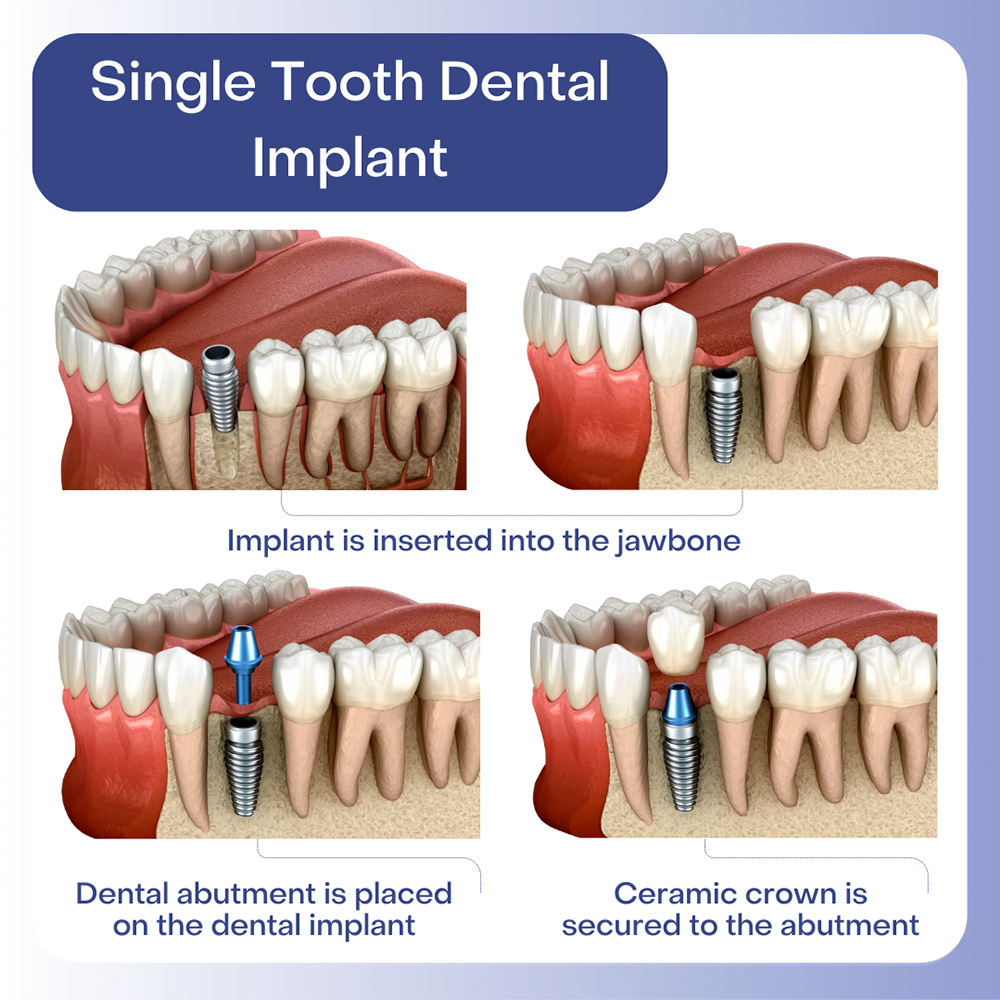The Best Guide To Dental Sense
The Best Guide To Dental Sense
Blog Article
The smart Trick of Dental Sense That Nobody is Talking About
Table of ContentsDental Sense for BeginnersRumored Buzz on Dental SenseSome Known Details About Dental Sense 8 Simple Techniques For Dental Sense
are medical devices surgically implanted right into the jaw to recover a person's capability to eat or their appearance. They offer support for synthetic (fake) teeth, such as crowns, bridges, or dentures. When a tooth is shed due to injury or illness, an individual can experience issues such as fast bone loss, malfunctioning speech, or adjustments to chewing patterns that lead to discomfort.Dental dental implant systems consist of a dental implant body and dental implant joint and might likewise include a joint addiction screw. Same day dental implants. The oral implant body is surgically put in the jawbone instead of the tooth's root. The dental implant abutment is normally connected to the dental implant body by the abutment addiction screw and expands via gum tissues right into the mouth to sustain the affixed artificial teeth
(http://peterjackson.mee.nu/where_i_work#c2504)Structure of The Dental Implant System picking oral implants, speak with your oral company about the possible benefits and threats, and whether you are a prospect for the procedure. Points to think about: Your total health is a vital consider identifying whether you are an excellent candidate for dental implants, how much time it will certainly require to recover, and the length of time the dental implant may remain in location.
Smoking cigarettes may impact the healing process and reduce the lasting success of the implant. The healing procedure for the dental implant body might take several months or longer, throughout which time you normally have a short-lived joint instead of the tooth. the oral implant procedure: Thoroughly adhere to the oral hygiene directions provided to you by your oral company.
Our Dental Sense PDFs
Implant failure can result in the demand for an additional operation to deal with or change the implant system. Brings back the capacity to chew Restores cosmetic look Assists keep the jawbone from shrinking as a result of bone loss Preserves the wellness of the bordering bone and periodontals Aids maintain surrounding (neighboring) teeth stable Enhances quality of life Damage to bordering natural teeth during implant placement Injury to the surrounding cells throughout surgical treatment, such as sinus perforation Injury during surgical treatment (as an example, fracture of surrounding jawbone) Insufficient feature, such as seeming like the teeth do not attack with each other generally An experience that the tooth is loosened or turning in position arising from a joint screw loosening up Implant body failing (looseness of the dental implant body) due to systemic infection, which might be more probable in clients with unchecked diabetes due to neighborhood infection look what i found in bone and gums supporting the dental implant body due to delayed healing, which may be most likely in clients that smoke Difficulty cleaning the gum tissues around the implant, leading to inadequate dental health Untreated periodontal illness Post-surgical feeling numb due to nerve impingement or damage Always notify healthcare providers and imaging professionals that you have oral implants prior to any kind of magnetic resonance imaging (MRI) or x-ray procedures.
FDA is not knowledgeable about any kind of negative events reported for MRI or x-ray procedures with oral implants. Oral implants systems are typically made from products that adhere to global consensus criteria of the International Company for Standardization (ISO) or ASTM International. These standards have information of what makes a risk-free material.

A dental implant is a framework that replaces a missing out on tooth. With screw-like gadgets, the doctor inserts a dental implant into the jawbone, and it serves as a support for a man-made tooth, called a crown. A device called an abutment links the fabricated tooth to the oral implant. The crown is customized to fit the individual's mouth and match the color of their teeth.
About Dental Sense
Some people are not eligible for oral implant surgery. It is for oral specialists to operate on people with: intense illnessuncontrollable metabolic diseasebone or soft cells condition or infectionIf these problems are settled, a person can have the surgical treatment. In, oral surgeons avoid running on individuals with: If individuals with any one of the above undertake dental implant surgical procedure, there is a higher risk of the implant failing.

Oral dental implant surgery is a personalized process. Offer you time to recover. Affix the article and last crown, bridge or denture.
Next off, your cosmetic surgeon will meticulously put the dental implant into your jaw. If your dental implant is near the front of your mouth, your dental practitioner will make a temporary tooth for you to wear up until you heal.
Not known Incorrect Statements About Dental Sense
Throughout the recovery stage, your jawbone needs to fuse to the dental implant. This process can take anywhere from three to 9 months.
As soon as your implant heals, your dental practitioner can connect the abutment (little port message) and your last remediation (crown, bridge or denture). This typically takes about one hour to finish and may call for a second minor surgery. You should not really feel any discomfort throughout your dental implant procedure because your company will use medication to numb your gums.
Report this page